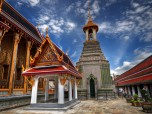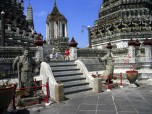At 1,372,625 hectares, the Okapi Wildlife Reserve covers around one-fifth of the Ituri forest in the northeastern part of the Democratic Republic of Congo. The reserve was established to protect the high diversity of species, especially those endemic to the Ituri forest. The animal from where it derived its name, the okapi (Okapia johnstoni), is the only living relative of the giraffe. It looks like a stumpy short-necked giraffe and has stripes on its rear legs similar to those of the zebra’s. The reserve is home to around 5,000 okapis. The reserve was listed as a UNESCO World Heritage Site in 1996.
Aside from the okapis, the Okapi Wildlife Reserve is also home to around 4,000 elephants, 2,000 leopards, 300 species of birds, thirteen species of primates including chimpanzees, three species of crocodile, and other animals of the rainforest like the forest buffalo, water chevrotain, forest elephants, insects, and antelope. It is in fact also one of the important sites in mainland Africa dedicated to bird conservation. Its human inhabitants belong to the Mbuti and Efe pygmies who are considered to be one the few remaining “forest people” of the world.
Other than witnessing the culture of these people and seeing the wild animals in their natural habitat, visitors to the Okapi Wildlife Reserve can expect to witness dramatic sceneries such as the Nepoko River in the north and the Ituri River in the south. There are also waterfalls and the majestic Mbiya Mountain situated at the edge of Epulu, overlooking the village. As the reserve is in the middle of the forest, it is a relatively calm and safe place where one can breathe in the fresh air and commune with nature. Camping and jungle activities may be arranged with the reserve’s administrators. As this is still part of the Democratic Republic of Congo, one should still consider taking the necessary safety precautions when traveling.










 Summerdale is a rural town in south-central Baldwin County, Alabama. It is part of the Daphne–Fairhope–Foley Micropolitan Statistical Area. With roughly 655 people living in the area and it being just minutes away from the beaches of the Gulf of Mexico, Summerdale is a place for peace and relaxation.
Summerdale is a rural town in south-central Baldwin County, Alabama. It is part of the Daphne–Fairhope–Foley Micropolitan Statistical Area. With roughly 655 people living in the area and it being just minutes away from the beaches of the Gulf of Mexico, Summerdale is a place for peace and relaxation.












































